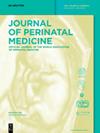超声波治疗产后出血的当前做法:对一项全国调查的二次分析
IF 1.7
4区 医学
Q3 OBSTETRICS & GYNECOLOGY
引用次数: 0
摘要
目的 虽然在产房中经常使用超声波,但目前的指南并不建议在产后出血(PPH)的情况下使用超声波。本调查旨在评估 PPH 期间常规使用超声波检查的情况。方法 向目前在产科工作的意大利妇产科超声学会成员发送了一份调查问卷,其中包括一系列评估参与者特征和 PPH 期间超声使用情况的问题。随后根据参与者的特征对答案进行了分组。结果 根据 200 名参与者的回答,67% 的参与者在 PPH 时常规使用超声波,85% 的参与者在怀疑有受孕残留物 (RPOC) 时常规使用超声波,67% 的参与者在放置巴克里球囊时常规使用超声波,69% 的参与者在刮宫术中常规使用超声波。在分娩次数较多的医院工作的参与者、拥有较多年分娩超声波使用经验的参与者以及参加过特定研究生培训课程的参与者中,常规超声波使用率较高。结论 尽管目前的指南中缺乏相关建议,但本次调查结果显示,母体胎儿医学从业人员在处理 PPH 时似乎普遍使用了超声波。本文章由计算机程序翻译,如有差异,请以英文原文为准。
Current practice of ultrasound in the management of postpartum hemorrhage: a secondary analysis of a national survey
Objectives Although frequently employed in the delivery room, current guidelines do not recommend the use of ultrasound in the setting of postpartum hemorrhage (PPH). The aim of this survey was to evaluate the routine use of ultrasonography during PPH. Methods A questionnaire, composed by a series of questions that assess participant characteristics and ultrasound use during PPH, was sent to members of the Italian Society of Ultrasound in Obstetrics and Gynecology currently employed in obstetrical units. Answers were subsequently grouped based on participant characteristics. Results Based on the responses of 200 participants it was found that ultrasound was routinely employed by 67 % of participants during PPH, by 85 % if Retained Products of Conception (RPOC) was suspected, by 67 % during Bakri balloon placement and by 69 % during curettage procedures. Routine ultrasound use was higher amongst participants working in hospitals with a higher number of deliveries, by those with more years of experience using ultrasound in labor, and by those that had attended specific postgraduate training courses. Conclusions Despite the lack of recommendations in the current guidelines, the results of this survey show that ultrasound seems to be commonly employed by maternal fetal medicine practitioners in the management of PPH.
求助全文
通过发布文献求助,成功后即可免费获取论文全文。
去求助
来源期刊

Journal of Perinatal Medicine
医学-妇产科学
CiteScore
4.40
自引率
8.30%
发文量
183
审稿时长
4-8 weeks
期刊介绍:
The Journal of Perinatal Medicine (JPM) is a truly international forum covering the entire field of perinatal medicine. It is an essential news source for all those obstetricians, neonatologists, perinatologists and allied health professionals who wish to keep abreast of progress in perinatal and related research. Ahead-of-print publishing ensures fastest possible knowledge transfer. The Journal provides statements on themes of topical interest as well as information and different views on controversial topics. It also informs about the academic, organisational and political aims and objectives of the World Association of Perinatal Medicine.
 求助内容:
求助内容: 应助结果提醒方式:
应助结果提醒方式:


